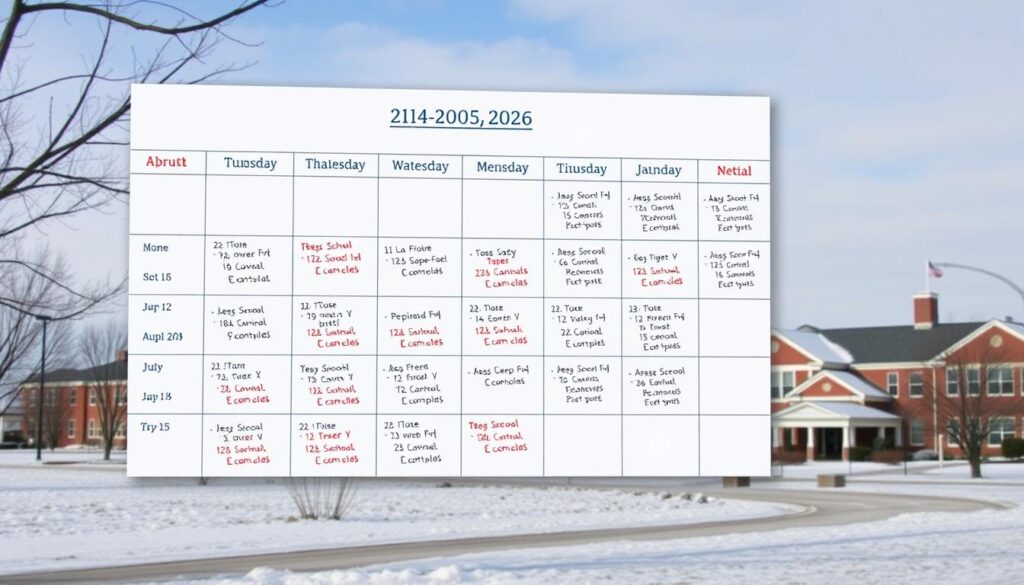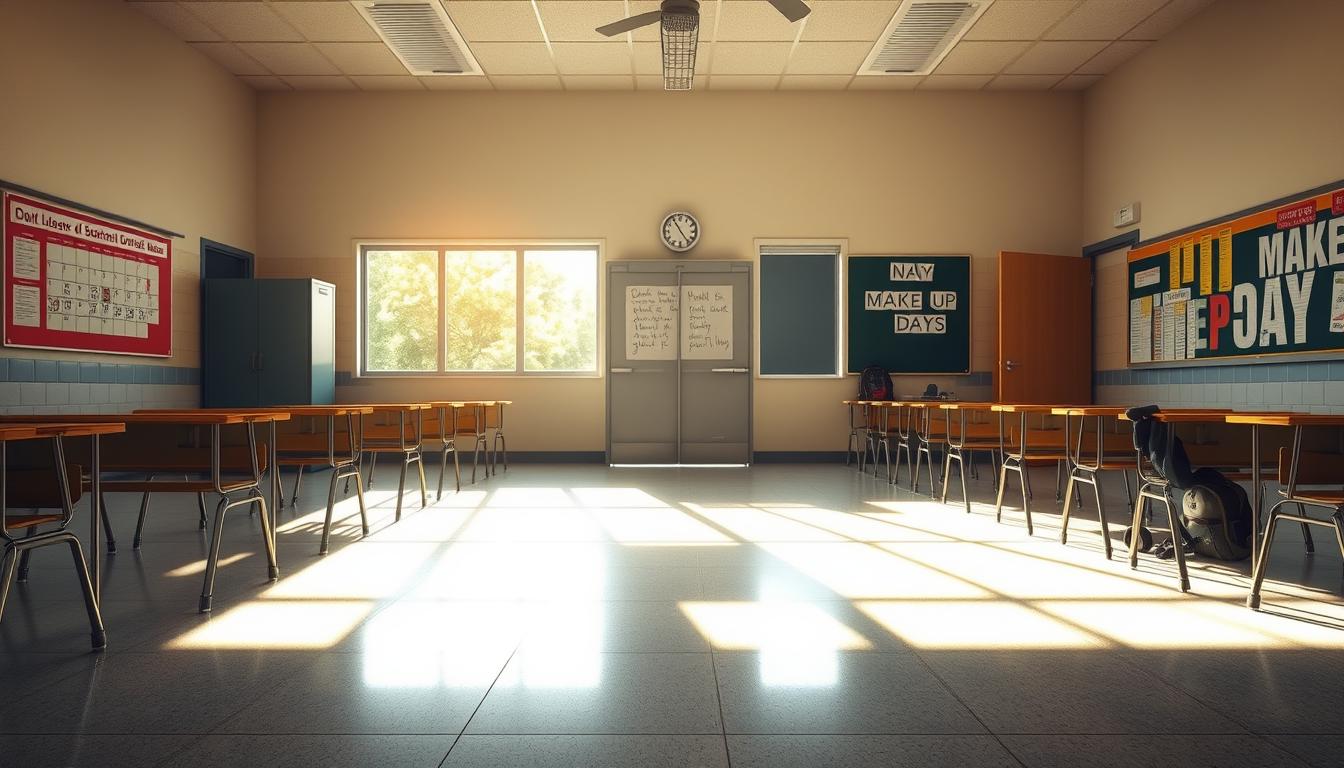School closings and delays happen often due to weather or other issues. It’s important for parents, students, and staff to stay updated. This guide will help you understand and deal with school schedule changes.
Key Takeaways
- Understanding the different types of school closures and delays
- Exploring the common reasons that lead to schedule changes
- Identifying the impact of closures on educational continuity
- Discovering how to stay informed about school schedule updates
- Preparing for school closures and delays as a parent or caregiver
Understanding School Closings and Delays: A Comprehensive Guide
Weather-related closures and delays can really affect students’ learning. Whether it’s a snowstorm or a problem with the school building, it’s important to know why schools close. This helps parents and the community understand what’s happening.
Types of School Closures
Schools can close in different ways. Sometimes, they close for the whole day. Other times, students go home early or start late. This allows schools to deal with weather or other issues.
Common Reasons for Delays
- Severe weather conditions, such as heavy snowfall, ice storms, or extreme temperatures
- Facility issues, like power outages or burst pipes
- Safety concerns, including threats or emergency situations
- Teacher or staff unavailability due to illness or transportation difficulties
Impact on Educational Continuity
School closures and delays can really mess up learning. They can stop lessons, assignments, and student progress. Teachers have to change their plans to keep students on track.
“The impact of school closures can be significant, especially for students who rely on the structure and resources provided by the education system. It’s essential to have a plan in place to minimize the disruption and ensure that students can continue their learning journey.”
How to Stay Informed About School Schedule Changes
It’s important for parents and students to know about school schedule changes. School districts use different ways to send out updates. By knowing these methods, you can keep up with any changes and plan better.
District Notifications
Most school districts have an official website with the latest updates. These websites have special sections or alerts for parents. You can check them for the newest information.
Automated Phone Systems
Many districts use automated phone systems to send district notifications. These systems call or text registered numbers with important messages. This way, parents get the news fast.
Social Media Platforms
School districts also use social media like Facebook, Twitter, or Instagram. They post class schedule changes and other news. Following your district’s social media can keep you updated in real-time.
| Communication Channel | Key Features |
|---|---|
| District Website | Dedicated sections for shool slosings and delays, class schedule changes |
| Automated Phone System | Recorded messages and text alerts for district notifications |
| Social Media | Real-time updates on Facebook, Twitter, and Instagram |
By knowing these ways to get updates, you can always be informed. This includes any shool slosings and delays or class schedule changes in your district.
TO WATCH VIDEO CLICK HERE
Shool slosings and delays: What Parents Need to Know
School postponements and education disruptions are becoming more common. It’s vital for parents to stay informed and ready. When schools close or delay, parents need to know how to handle it.
Emergency Contact Information
Make sure your child’s school has your current emergency contact details. This includes phone numbers, email addresses, and backup caregivers. This way, the school can quickly reach you if there are any schedule changes or emergencies.
Alternative Childcare Plans
Have a solid childcare plan ready, in case of school closures or delays. Find trusted friends, family, or local childcare providers to care for your child when needed.
Communication Channels
- Get to know how your child’s school communicates, like email, text alerts, and social media.
- Check the school’s website and district channels for updates on school postponements and disruptions.
- Join any school notification systems, like automated calls or texts, to get timely updates.
By staying informed, keeping contact info current, and having a plan, parents can handle school closures and delays better. This helps minimize the impact on their children’s education.
Weather-Related School Closure Protocols
When bad weather hits, schools must decide if they should close or delay. These decisions are made with safety in mind. They look at real-time weather and local forecasts to make these tough calls.
They also check the roads and how safe they are. Schools work with local departments to see if it’s safe for buses and families to get to school. They look at snow, ice, and how well you can see.
They also watch the temperature and wind chill. Cold weather can be dangerous, especially for kids who walk or wait at bus stops. They talk to meteorologists and local officials to see if it’s too risky to open school.
Deciding to close schools is a big deal. They look at inclement weather alerts and snow day announcements. They also work with the community to make sure everyone knows what’s happening.
By following these rules, schools try to keep everyone safe. They aim to balance keeping schools open with protecting students and staff during bad weather. These plans are key to keeping the school community safe.
Digital Notification Systems for School Delays
In today’s world, schools use new ways to tell students, parents, and the community about changes. This includes closures and delays. These systems send out important info fast, helping families plan better.
Mobile Apps and Alerts
Many schools have mobile apps for district notifications about closings and class schedule changes. Parents get alerts on their phones, keeping them updated. These apps have features like push notifications and customizable settings.
Social Media Updates
Social media is key for schools to share news. They use Facebook, Twitter, and Instagram to post updates. Parents can follow their school’s social media to get the latest news.
District Websites
School district websites are a central place for news and updates. Parents can check their child’s school or district website for the latest. Many sites let you sign up for email or text alerts.
Schools use different digital channels to reach families. This keeps parents informed about school changes. It helps them plan and stay connected with their child’s education, even when there are surprises.
Making Up for Lost School Days
When schools close unexpectedly, teachers must find ways to catch up. They use different strategies to make sure students get the education they need. This is done while keeping the community’s needs in mind and dealing with education disruptions.
One way is to add extra days to the school year. This helps meet the required hours without changing the schedule too much. It’s a common solution to make up for lost time.
Another method is to add a few minutes to each school day. Over time, this adds up to the needed hours. It’s a small change that doesn’t disrupt daily life too much.
Some schools also use “snow days” to catch up. If they don’t use up all their extra days, they can stick to the original schedule. This way, they avoid long school days or changing the calendar.
| Approach | Advantages | Disadvantages |
|---|---|---|
| Extend School Year | Meets instructional hour requirements Maintains existing daily schedule | Delays summer break Potential conflicts with family plans |
| Add Minutes to School Days | Minimally impacts daily routines Gradual accumulation of hours | Longer school days Possible fatigue for students and staff |
| Utilize Built-in “Snow Days” | No need to adjust calendar or schedules Avoids disruption to families | Limited number of buffer days Unexpected closures may exceed allotment |
By trying out these options, schools can keep the impact of academic calendar adjustments and education disruptions small. This helps students learn without too much disruption.

Impact of Closures on School Activities and Events
School closures or delays can really mess up school activities and events. They affect sports, clubs, and even when and how we take tests. These cancellations can throw off the whole school year.
Sports and Extracurriculars
When school days get cancelled, sports and clubs have to be rescheduled. Schools try hard to find new dates for these events. They want students to keep showing off their skills.
Academic Calendar Adjustments
School cancellations mean we often have to change the school calendar. We might add days to the school year or shorten breaks. These changes can be tough for families and mess up our usual school routine.
Testing Schedules
Test days, like state exams or college entrance tests, can get pushed back too. Schools work with testing groups to find new dates. This way, students can still show how well they’re doing in school.
Handling school closures well takes teamwork from everyone. School leaders, teachers, and parents need to work together. This way, we can keep school going smoothly and make sure students get the chance to succeed.
Remote Learning Options During School Closures
Remote learning has become key as schools close. Digital platforms and tools help students keep learning at home. This new way of learning keeps education going, even when schools can’t open.
Big online learning sites like Coursera, Udemy, and edX now offer more courses. They have video lessons, interactive activities, and self-paced courses. This lets students learn new things and gain skills when schools are closed.
Schools also use virtual classroom tools like Zoom, Google Classroom, and Microsoft Teams. These tools help teachers teach live and students can join in. It keeps learning fun and connected, even when students are apart.
FAQ
What are the different types of school closures?
Schools can close for a full day, have an early dismissal, or start late. This is due to severe weather, facility issues, or safety concerns.
Why do schools cancel or delay classes?
Schools close or delay classes for many reasons. This includes bad weather, power outages, emergencies, or other disruptions that make it unsafe or impractical to hold classes.
How do school districts notify families about schedule changes?
Schools use many ways to tell families about closings and delays. This includes website updates, automated phone calls, text messages, social media, and mobile apps.
What should parents do to prepare for school closings and delays?
Parents should keep their emergency contact info up-to-date. They should also have a backup plan for childcare and know how their school communicates.
How are decisions made for weather-related school closures?
School administrators look at road conditions, temperature, and weather forecasts. They decide if schools should close due to bad weather.
What digital tools do schools use to notify families about schedule changes?
Schools use mobile apps, text alerts, social media, and district websites. They use these tools to quickly share information about class schedule changes.
How do schools make up for lost instructional time due to closures?
Schools might extend the school year or add minutes to each day. They also use “snow days” in the academic calendar to make up for missed time.
How do school closures impact extracurricular activities and events?
Closures and delays can cause sports, extracurricular activities, and tests to be rescheduled. They also affect the academic calendar and graduation dates.
What remote learning options are available during extended school closures?
During long closures, schools use digital learning platforms and virtual classroom tools. They aim to keep education going and support learning from home.
TO SEE MORE TOPICS CLICK HERE



